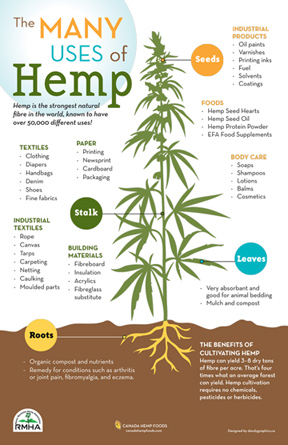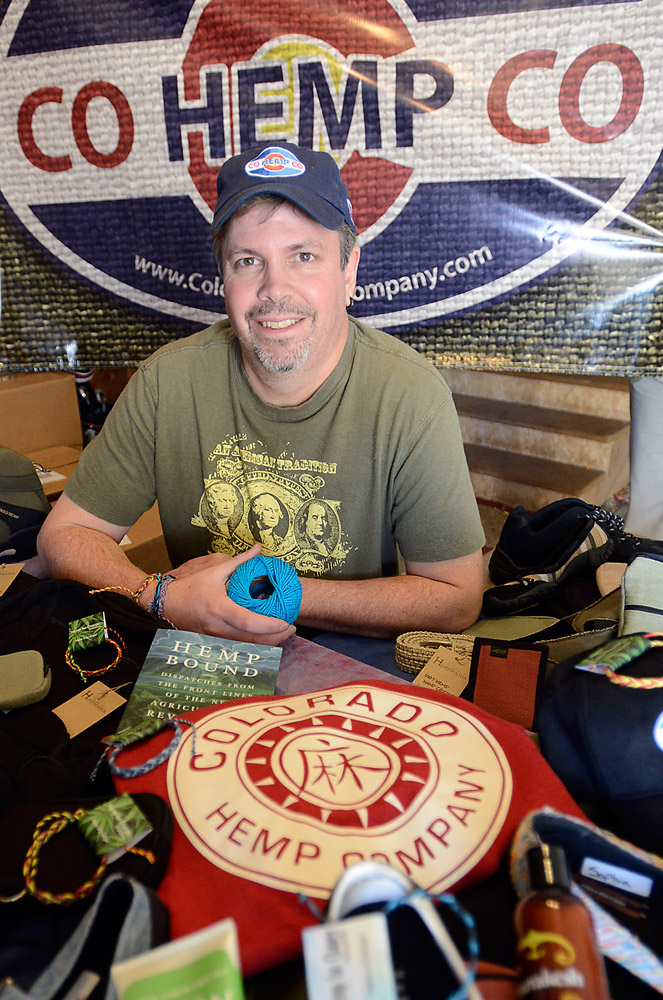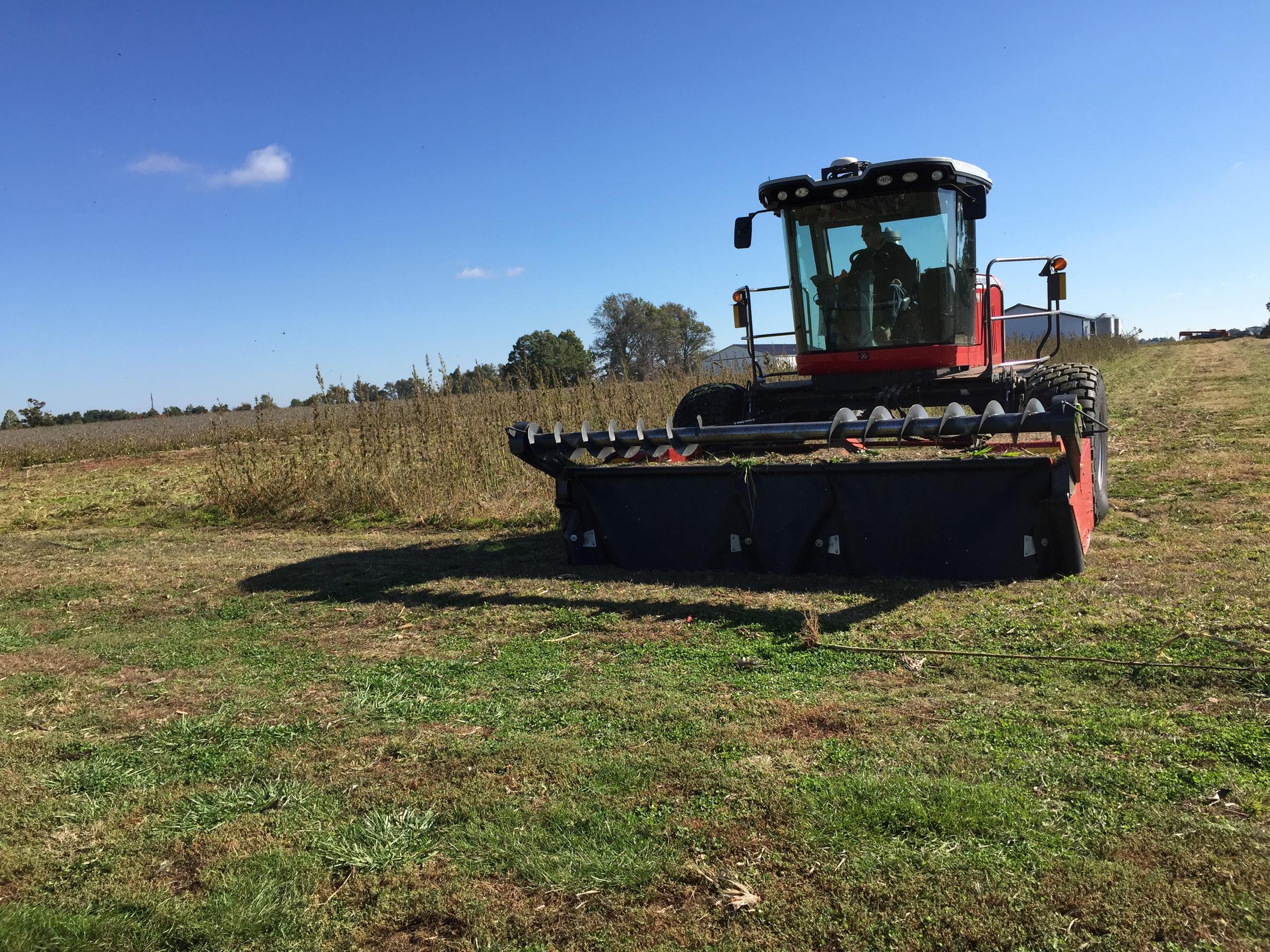New technologies are only beginning to unlock the possibilities of hemp.
By Doug Fine
Source: alternet.org

The first digital-age domestic hemp crop is being harvested as I write. The subtle decrease in seismic activity currently puzzling Virginia geologists can be traced to Thomas Jefferson ceasing to spin in his grave for the first time in 77 years.
For a century USDA biologists conducted taxpayer-funded hemp cultivar research for farmers, after all. They did this in a Virginia meadow that is today the Pentagon. And why wouldn’t they, in support of a key crop supplying the Navy with rope and earning millions for farmers from Wisconsin to Kentucky (when millions meant something)?
Then there was this weird quirk (Google “cannabis prohibition” if the cause of the quirk is news to you), and it took a tucked-in provision in the 2014 federal Farm Bill to allow hemp research to restart.
As I learned while researching my latest book,
Hemp Bound, this longest utilized of agricultural products (today defined as “cannabis with less than point three percent of psychoactive THC”) is offering up a genuine opportunity to provide food and energy independence for the U.S. and beyond while stimulating a multi-billion-dollar agriculture-based economy. It might even lead to fewer resource wars. Just that.
This is what happens when you cultivate a plant for 12 millennia. It develops a broad range of helpful properties. Want some in-the field proof?
Last week, on a suspiciously hot late September morning, I was standing in the middle of a two-acre hemp plot in Sterling, Colorado, absentmindedly nibbling ripe, Omega-balanced seeds right off the flower, while conducting an interview. I was surrounded by hemp plants taller than I. Every now and then a piercing train whistle from Warren Buffet’s BNSF nearby freight line interrupted the bee chatter.
Bill Billings, John Deere ball cap-wearing president of the Colorado Hemp Project that had commissioned this field from 67-year-old local farmer Jim Brammer, was answering my question about how the fiber side of this harvest (from a Chinese cultivar) was going to be used.
“Supercapacitors,” he said. He said it off-handedly. What struck me was the absence of braggadocio. It was like he was suggesting the crop was going to be used for livestock bedding (a profitable, if longstanding fiber app for hemp in Europe and, starting in 2015, the Thoroughbred market in Kentucky).
Supercapacitors are next-generation battery storage components – the kind of technology that’s going to allow a solar-powered ranch like mine to charge a week’s worth of energy from an hour of sunlight. Seems the ridged shape of hemp, when reduced to nano-sized carbon atom sheets (called graphene), causes it to outperform previously leading modes of experimental (and, by the way, environmentally unfriendly) energy storage at, according to a paper delivered at the 2014 meeting of the American Chemical Society, 1/1000th of the cost. Just that.
Billings and the deciders at the Boulder-area tech company with which the Colorado Hemp Project is partnering for the Sterling harvest asked me to keep the specifics out of this piece because the deal’s still being finalized. But the buyer is an established player in the nano arena and its CEO told me via email, “We’re interested in hemp because we believe hemp will change the way energy is created, charged, and stored.”
Brammer, the overalls-clad farmer who sowed this Sterling crop, told me that hemp drank half the water the previous season’s GMO corn crop did. He also applied no pesticides or fertilizers to the hemp, and the dang crop in places was 10 feet tall. “I didn’t put nothing but water on this field this year,” he said.
And the plants were so flower dense! Canadian farms harvest an average of 800 pounds of hemp seed per acre, leading to $250 per acre profits right from the field. That’s five times soy profits. Those 800 pounds per acre, by the way, fetch north of $20 per pound retail. That’s why in this Tri-cropping model I hype vertical control of the industry by production communities: we’re talking $336,000 in revenue for a 20-acre hemp farm in Vermont. And that’s just for the seed.
Beyond the raw seed itself, value-added products like hemp protein juices and the Slovenian hemp/clay/mint toothpaste my family is plowing through at the moment just increase the earning potential for today’s struggling farming communities.
The Canadian industry is growing 24 percent per year. It’s poised to pass a billion dollars in revenue itself this year, its 16th in the modern era. Crew told me Canadian hemp oil (and seed cake) processors can’t keep up with demand. This is good for American farmers.
It’s also good for the planet: while all this money is being made, putting small farmers back to work, hemp is cleaning monoculture-damaged soil via its famous phytoremediation qualities. And as Brammer confirmed, no harmful pesticides are being added. “None needed,” says the Canadian Agriculture Department page dedicated to the plant.
Hemp is already changing the playbook for the embarrassingly low one percent of Americans who farm today (down from 30 percent when cannabis prohibition began in 1937). Sustainability mixing with profitability – this is why it matters that Brammer was seeing what a non-GMO crop can do. Sterling, Colorado is in Logan County, a part of the state so conservative that 42 percent of county voters chose to secede from the rest of the state last year. I’d seen this kind of rural local pride in Kentucky and Belgium in recent weeks as well: hemp is off the table as a culture war issue.
In the Bluegrass State, it’s a Kentucky Heritage issue for the former world hemp industry leader. Those heady days are still in the cultural memory. Don’t try to trash talk the cannabis plant in Lexington, in other words, where I attended a hemp industry meeting on the 28th floor of the Lexington Financial Center Building last week. There pinstripe suits were the norm, a Republican state senator (Paul Hornback) was in attendance, and hemp bullishness was de rigueur.
The Colorado Hemp Project seeds, by the way, were scrumptious, and imported versions of it are already in your supermarket, at that $20 a pound. Hang tight. Local hemp is on its way. I can introduce you to the farmers. For now. Soon you won’t need my help.
I knew as I munched that I’d be looking back in a few years in awe at how fast the U.S. hemp industry has grown even from these impressive beginnings. Colorado, Vermont and Kentucky, the three most active hemp states of the 19 with hemp cultivation laws this inaugural post-Farm Bill season, have, combined, fewer than 2,000 acres planted this year (both of Hemp Bound’s 2013 hemp farming heroes, Michael Bowman and Ryan Loflin, were at it again in ’14 as well). Colorado is the only state that permitted commercial cultivation this year, ahead, let us hope briefly, of federal law. “For research purposes” is still the law of the land.
Research plots though they may be cultivating, farmers in Kentucky have also been allowed to sell their harvest. In fact, every molecule of seed and fiber from every hemp field I visited this debut season had a buyer. That’s both saying a lot and not. It’s not much acreage, but it’s a dang good way to look back on an industry in 20 years: every single farmer always has had a buyer for everything she grew.
Furthermore, I think we’ll see an impressive 15-fold increase in hemp acreage in 2015, to 30,000 cultivated acres.
More even than Canadian processor Crew’s plea in Hemp Bound for American hemp cultivators to meet the double-digit increase in demand for the seed harvest, I love seeing the “hemp farmers wanted” page on Vermont oil processor American Seed and Oil’s web site. This industry is hiring!
And it is comprised of classic American go-getters. My email inbox just pinged with a cc:d note from 40-year-old Kentucky farmer and non-profit executive Mike Lewis, an Army vet whose Growing Warriors project is providing some of the hemp fiber that will go into the paper for a coming project of mine. He can get the fiber to the pulp mill “in a couple of weeks,” he said to Morris Beegle, the fellow pioneering domestic hemp printing care of his Colorado Hemp Company. Think of the carbon-savings when not only is the entire publishing industry tree-free, but the hemp pulp doesn’t need to be shipped to or from overseas.
“But, hey,” you might be asking, “Is the infrastructure in place to develop a new industry, albeit derived from a very ancient ag product that was successful from Neolithic times through 1937?”
All I had to do to answer that question in the Sterling hemp field was turn around. Remember those startlingly loud BNSF train whistles? Their sources were half mile-long lines of freight cars chugging by every 20 minutes, in easy walking distance from where I stood stuffing my face with protein and magnesium.
I predict that within the next two decades, today’s domestic diesel-powered transportation grid (including trucking) will be at least partly powered by U.S.-grown hemp oil. This, I hope, will be part of a transition to a hemp graphene-based electric transportation system charged by the sun and wind, supplemented by hemp biomass power at a distributed, regional, community-owned grid system. This is safer for America than one centralized master grid.
Furthermore, the fracking rigging with which the cars were loaded down this September day (a fracking industry employee at the Sterling field with me kept pointing out “directional drill pipes” and “flex drill collars” in some of the open BNSF cars, and I could see multiple active fracking rigs scarring the landscape on the drive from Denver) will give way to trainloads of hemp seed and fiber by the millions of tons. It’s win-win. Trains and trucks powered by plentiful, domestic, carbon-friendly hemp, delivering lucrative hemp to markets worldwide. Even the hemp-harvesting tractor bodies will be made from hemp fiber. If this sounds crazy to you, next time you’re in a Mercedes, kick the door panel. It won’t dent or budge: it’s made partly of hemp fiber today.
But how do we get there? What does a hemp-intensive economy look like on the ground? To answer that, we head 1,100 miles east from the Sterling food/battery field. I learned when I set-out to kick petroleum in 2006 for an earlier book that such a big slice of the project we humans have in front of us (if we want to survive) involves developing regional economies -- food economies, energy economies, industrial economies. Think of this as the dawn of the post-Globalization era.
Because of what all my research concludes is this locavore imperative, it shouldn’t have surprised me that another indelible memory from the Hemp Harvest Tour went down on the farm of a Kentucky veteran who began fighting for food security when his brother came home wounded from Afghanistan and had to apply for Food Stamps. This became what you might call the Hemp Heritage branch of the tour.
On a more properly autumnal afternoon, I wound south from Lexington through hills and hollows to the Rockcastle County farm that the bearded Lewis has turned into hemp headquarters for the Growing Warriors food security project of which he is executive director. There at New Constellation Farm I found myself in the barn holding hand-broke hemp bast for the first time. Lewis and I had just processed the fiber in question.
We did it care of a wooden hemp break. These are simple levered devices about the size of a horse that have been used for a few millennia to remove the plant’s valuable bast (long) fiber after the outer bark softens in the field through a process called retting. After the bark is peeled and the bast fiber removed, the shorter hurd fiber is caught in a bin underneath the machine, for use in applications like hempcrete (a building mixture comprised of hemp hurd and an organic binder like lime that insulates better than fiberglass and is all the rage in Europe) and the above-referenced livestock bedding.
The break we were using was a shiny new device built by Lewis’ farm manager Kevin Lansi based on a traditional and ubiquitous design like the 70-year-old one Kentucky hemp pioneer Craig Lee and my pard Mose Putney had just discovered in the barn of a 5,000-acre antebellum hemp plantation that’s today the Walnut Hall Thoroughbred Ranch. Lee and Putney had kindly invited me and my Kentucky host Josh Hendrix (founder of the Kentucky branch of the Hemp Industries Association) along on their sleuthing.
A mechanized but expensive machine called a decorticator allows farmers and processors to skip the risky and time-consuming field retting stage. Without one of those doo-hickies, the harvest relies on muscles, rather than electrons. But I was surprised to find that retting hemp fiber isn’t that hard. I kind of expected that it would take a hundred sharecroppers a month to process a pound of fiber. In fact, a play-by-play goes like this:
Lift hemp break lever. Lay handful of retted hemp stalks on the platform below. Clomp clomp clomp with the lever. Easily pull off bark, exposing treasure of the world’s strongest natural fiber therein. Add to pile.
I recall that the moment the first tangly cord of that Kentucky fiber hit my hand in the Growing Warriors barn my palm enacted a sort of cinematic double take. That’s because it was soft as silk and stronger than steel. Believe me, I tried to rip it, karate chop it and stomp it.
What shocked me was not that hemp’s durability rep was deserved (I’d held the production line bast fiber that goes into those Mercedes door panels), but that Kentucky farmers were nailing it right out of the gate. “I do a lot of reading,” Lewis admitted. Still, I thought this field-retted, hand-processed hemp had to be inferior to what the experienced big guys were doing in Europe.
Nope. This bundled skein of fiber was good enough for that most ancient and demanding of hemp applications: textiles. Listen up, struggling South Carolina clothing mill communities: later that day, a local seamstress named Stephanie Brown picked up a armful of said fiber from Lewis. “This’ll be on my loom tomorrow,” Brown told me proudly.
And so an industry returns. Sure, we’re likely to soon be talking about machine-processed hemp by the thousands of tons. That’s terrific. What Lewis, Brown and crew showed me was a start, from (modern) year one. As Newton teaches us, launching is the hardest part. Once you do, everything is scalable.
For Lewis, as important as hemp is, even more important is developing a rural locavore industry of any kind. “Kentucky is lucky because our topography long ago created a network of small farms, rather than huge plantations,” he told me as we strolled New Constellation’s four hundred eighty six acres (two dedicated to hemp this year, twenty-five next year). “Hemp is perfectly suited here for a broad range of regional industries made up of networks of independent farmer/entrepreneurs.”
Vertical control of your industry: work for it in your own community. Then you don’t have to worry so much about Wall Street’s vicissitudes.
Start with rural community-owned hemp processing that breeds vibrant regional economies. Add local energy through biomass gasification, hemp-based batteries to store it, drought-resistant plants, soil phytoremediation and seed oil superfood to the mix, and forget fantasy. There is no eventual actual hemp role in our future too grandiose to astound me at this point.
In other words, get ready for an entire hemp market sector that will be included in the top-of-the-hour business wraps. The reality of hemp on the ground as its first federally authorized crop in the 21st century is harvested has exceeded even my most sanguine expectations.
Phew. It wasn’t a mistake to have (human and goat) kids in the 21st century. After I milk the goats this morning, I’m off on a hike up the eponymous Funky Butte with both species, and I’m feeling more confident about my replicants’ future than I have since last year’s second “Millennial” flood this decade wiped out the Funky Butte Ranch driveway again.
Part of the reason for my confidence is I know that from the top of the Butte I can map out the five acres I plan on devoting to hemp the moment full commercial legalization arrives. Call your Senators: S-359 takes us beyond “research” cultivation and gets us all planting: The Industrial Hemp Farming Act. God Bless America and God Bless Those Hemp Farmers.
Postscript: Everlasting thanks to Josh Hendrix and Jason Lauve, without whom the harvest tour wouldn’t have happened. I’ll never forget it. Other than when some leftovers exploded in Josh’s Ford around a tough Bluegrass State curve near his grandfather’s ranch, there wasn’t an un-blissful moment on the whole tour. Josh, 29, is founder of the Kentucky branch of the Hemp Industries Association and Jason’s hemp CV is too long to list: suffice it to say the forty-four-year-old was a principal player in hemp’s legalization in Colorado, and as I write is on his way to a hemp decorticator facility in North Carolina. He is also one of the key players that made the 2014 Sterling crop a reality.
Doug Fine is the author of
Farewell, My Subaru, Too High to Fail, and most recently,
Hemp Bound. Books and films:
Dougfine.com Twitter: @organiccowboy.






